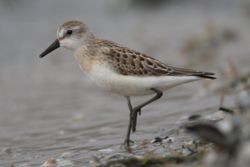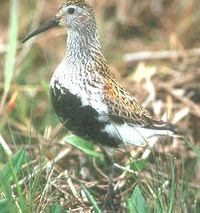|
Waders |

Semipalmated Sandpiper (Calidris pusilla)
|
|
Scientific classification |
| Kingdom: |
Animalia
|
| Phylum: |
Chordata
|
| Class: |
Aves
|
| Order: |
Charadriiformes
|
| Suborder: |
Charadrii
|
|
| Families |
Scolopacidae
Rostratulidae
Jacanidae
Thinocoridae
Pedionomidae
Burhinidae
Chionididae
Pluvianellidae
Ibidorhynchidae
Recurvirostridae
Haematopodidae
Charadriidae
|

Dunlin (Calidris alpina).
Waders, called Shorebirds in
North America (where "wader" is used to refer to
long-legged wading
birds such as
storks and herons), are members of the order
Charadriiformes, excluding the more marine web-footed
seabird groups. The latter are the
skuas (Stercoraracidae),
gulls (Laridae),
terns (Sternidae),
skimmers (Rhynchopidae), and
auks
(Alcidae). Also, the
pratincoles (Glareolidae) and the
Crab Plover (Dromadidae), which look more similar to
waders, are closely related to the seabirds.
This leaves about 210 species, most of which are
associated with wetland or coastal environments. Many
species of Arctic and temperate regions are strongly
migratory, but tropical birds are often resident, or
move only in response to rainfall patterns. Some of the
Arctic species, such
Little Stint are amongst the longest distance migrants,
wintering in the southern hemisphere.
The majority of species eat small invertebrates picked
out of mud or exposed soil. Different lengths of bills
enable different species to feed in the same habitat,
particularly on the coast, without direct competition for
food. Many waders have sensitive nerve endings at the end of
their bills which enable them to detect prey items hidden in
mud or soft soil. Some larger species, particularly those
adapted to drier habitats will take larger prey including
insects and small
reptiles.
Many of the smaller species found in coastal habitats,
particularly but not exclusively the
calidrids, are often named as "Sandpipers", but this
term does not have a strict meaning, since the Upland
Sandpiper is a grassland species.
In the
Sibley-Ahlquist taxonomy, waders and many other groups are
subsumed into a greatly enlarged Ciconiiformes order.
However, the classification of the Charadriiformes is one of
the weakest points of the Sibley-Ahlquist taxonomy, as
DNA-DNA hybridization has turned out to be incapable of
properly resolving the interrelationships of the group.
Formerly, the waders formed the suborder Charadrii, but this
has turned out to be a "wastebin" taxon, uniting no less
than four charadriiform lineages in a paraphyletic assemblage. Following recent studies
(Ericson et al., 2003; Paton et al., 2003;
Thomas et al., 2004a, b; van Tuinen et al.,
2004; Paton & Baker, 2006), the waders may be more
accurately subdivided as follows:
- Suborder Scolopaci
- Family
Scolopacidae: snipe, sandpipers, phalaropes, and
allies
- Suborder Thinocori
- Family Rostratulidae: painted snipe
Family Jacanidae: jacanas
Family Thinocoridae: seedsnipe
Family Pedionomidae: Plains Wanderer
- Suborder Chionidi
- Family Burhinidae: thick-knees
Family Chionididae: sheathbills
Family Pluvianellidae: Magellanic Plover
- Suborder Charadrii
- Family Ibidorhynchidae: Ibisbill
Family Recurvirostridae: avocets
Family Haematopodidae: oystercatchers
Family Charadriidae: plovers and lapwings
In keeping more in line with the traditional grouping,
the Thinocori could be included in the Scolopaci, and the
Chionidi in the Charadrii. However, the increasing knowledge
about the early evolutionary history of modern birds
suggests that the assumption of Paton et al. (2003)
and Thomas et al. (2004b) of 4 distinct "wader"
lineages (= suborders) already being present around the
C-T boundary is correct.
See also
References
- Ericson, P. G. P.; Envall, I.; Irestedt, M. &
Norman, J. A. (2003): Inter-familial relationships of
the shorebirds (Aves: Charadriiformes) based on nuclear
DNA sequence data.
BMC Evol. Biol. 3: 16.
DOI:10.1186/1471-2148-3-16
PDF fulltext
- Paton, Tara A. & Baker, Allan J.
(2006): Sequences from 14 mitochondrial genes provide a
well-supported phylogeny of the Charadriiform birds
congruent with the nuclear RAG-1 tree. Molecular
Phylogenetics and Evolution 39(3): 657–667.
DOI:10.1016/j.ympev.2006.01.011
(HTML abstract)
- Paton, T. A.; Baker, A. J.; Groth, J. G. &
Barrowclough, G. F. (2003): RAG-1 sequences resolve
phylogenetic relationships within charadriiform birds.
Molecular Phylogenetics and Evolution 29:
268-278.
DOI:10.1016/S1055-7903(03)00098-8
(HTML abstract)
- Thomas, Gavin H.; Wills, Matthew A. & Székely,
Tamás (2004a): Phylogeny of shorebirds, gulls, and
alcids (Aves: Charadrii) from the cytochrome-b
gene: parsimony, Bayesian inference, minimum evolution,
and quartet puzzling. Molecular Phylogenetics and
Evolution 30(3): 516-526.
DOI:10.1016/S1055-7903(03)00222-7
(HTML abstract)
- van Tuinen, Marcel; Waterhouse, David & Dyke,
Gareth J. (2004): Avian molecular systematics on the
rebound: a fresh look at modern shorebird phylogenetic
relationships. Journal of Avian Biology 35(3):
191-194.
PDF fulltext




